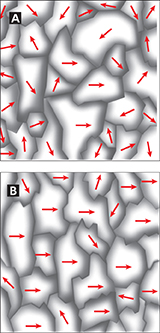Nonmagnetized Materials
The fact that a material is ferromagnetic does not mean it is a magnet. If the domains of a ferromagnetic material are aligned randomly, the magnetization of the domains is cancelled, and it is not a magnet. An iron nail is an example of a nonmagnetized material. It is ferromagnetic, so the domains have the potential to be aligned, but normally they are not. Figure 5A shows the random orientation of domains in nonmagnetized iron.
Magnetized Materials
You can easily magnetize a nonmagnetized ferromagnetic material by placing it in a magnetic field. For example, if you put a nonmagnetized iron nail near a magnet, you will turn the nail into a magnet. Figure 5B shows the alignment of magnetic domains in magnetized iron. The applied magnetic field causes magnetic domains aligned with the field to grow larger. This magnetization can be temporary. If the magnet is moved away from the nail, the motion of the atoms in the nail causes the magnetic domains to become randomly oriented again. In some ferromagnetic materials, the domains stay aligned for a long time. These materials are called permanent magnets. They are not truly permanant, because heat or a jarring impact can realign the domains.
If you cut a magnet in half, each half will have its own north pole and south pole because the domains will still be aligned. If you cut the pieces in half again, each half will again have a north pole and a south pole. No matter how many times you cut the magnets, each piece will have two different poles. A magnet can never have just a north pole or just a south pole.
Figure 5 A magnetic field can magnetize ferromagnetic materials.
A Before magnetization, domains are random. B Domains aligned with the field grow during magnetization. Unaligned domains can shrink.

Section 21.1 Assessment
Reviewing Concepts
 Describe the interaction of magnetic poles.
Describe the interaction of magnetic poles. What two things can happen to a magnet entering a magnetic field?
What two things can happen to a magnet entering a magnetic field? What makes a material magnetic?
What makes a material magnetic?Describe what happens to the fields of two bar magnets when you bring their north poles together.
Critical Thinking
Predicting What happens if you suspend a bar magnet so that it can swing freely?
Relating Cause and Effect How are electrons responsible for magnetism?
Predicting What will happen if you hit a magnet with a hammer? Explain.
Designing Experiments How could you test the effects of heating and cooling on the magnetization of a bar magnet?
Connecting Concepts
Electric Charge Review electric charge in Section 20.1. Compare the attraction and repulsion of positive and negative charges with the behavior of two bar magnets placed near one another.




